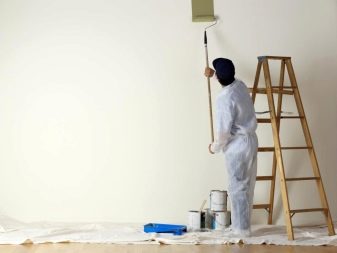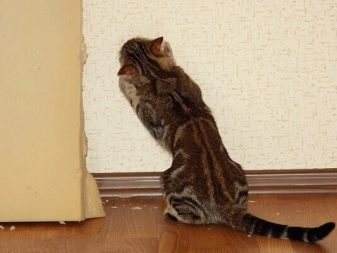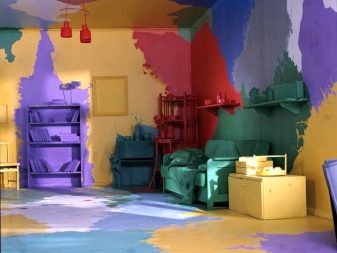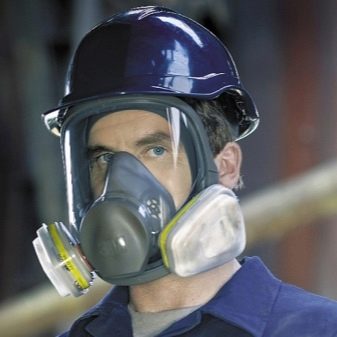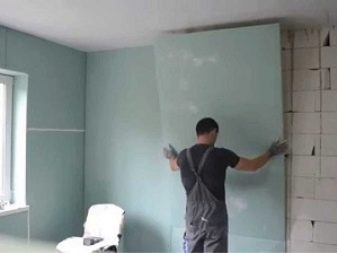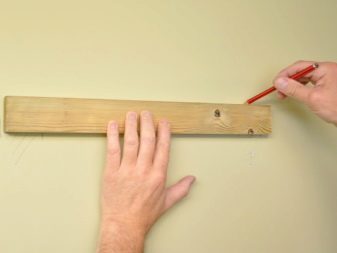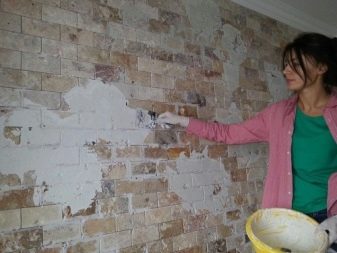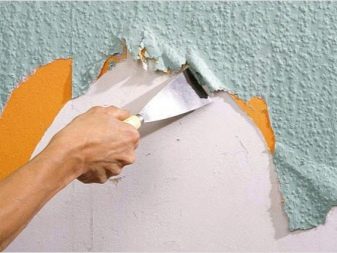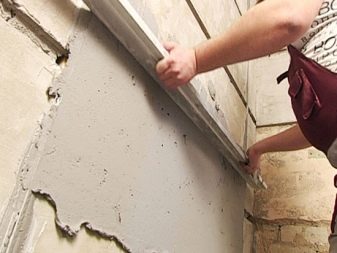Preparation of walls for painting: features, work order

If you want to achieve comfort in your own home, then you can not do without repairs. There are a number of rooms where painting walls is the only possible option. However, using modern paint you can paint any room and achieve an amazing result.
In order for your walls to be pleased with beauty, it is important that they are perfectly smooth, which is quite difficult to achieve without knowing the right technology works.
Pros and cons of painting
When planning repairs in any of the rooms in your home, you must decide in advance what you want to see there: glue the wallpaper, put tiles or steal the walls. The paint variant has both advantages and disadvantages, and you yourself have the right to decide what to look for when choosing.
The advantage of painting is:
- Positive effect on indoor climate. Walls that are prepared for painting correctly usually ground, treated with an antiseptic, which in turn prevents fungi from growing and multiplying with other microorganisms. All pits and cracks must be removed from the surface, which means that harmful microbes will have no place to develop;
- The speed and low cost of the procedure. If you have normal, even walls, and you just want to refresh the color, then within just a few hours you will get a ready-made result, at no extra cost;
- Ease of use. Painted walls are easy to clean, they can be quickly cleaned, removing traces of children's creativity, food stains, kitchen dirt, footwear dirt in the corridor and not only;
- Security. Painted walls will never interest pets, they will not scratch it like wallpaper, do not stain them forever with paws from the street, because the coating will retain its original appearance;
- Variability. Since there is a huge range of paints and varnishes on the market, using different colors, textures and surfaces, you can come up with the most unique and unique decor of any room.
Of the minuses, there are also a number of important aspects that you should pay attention to when choosing materials for finishing walls in a room.
There are such disadvantages:
- Wall preparation. If you have problem walls, then before painting them, you need to carry out a number of preparatory work, which will require the ability to work with different tools and surfaces;
- Process features. For a person without experience painting the walls is a lot of work, because it is important not just to paint on the wall, but to do it correctly in order to get the desired result;
If you are unable to do this yourself, you need to call professionals whose cost of services is not small.
- Care for painted walls. After the surface of the walls has been painted, it is important to wash it regularly in order to remove all small dust particles. Glossy paints do not need such a strong care;
- Fortress. Any walls, especially painted ones, will not withstand mechanical impact, any strong blows will cause cracks, and the paint will begin to peel off from the surface;
- Design. If you want to have at home not just plain walls, but an interesting pattern or texture, it is better to use the services of a designer and painter, because without experience you simply cannot achieve beauty and surface quality.
Almost any room in the apartment is subject to wall painting, but It is important to use this type of coating correctly.. Each room has its own functional purpose, and therefore the selection of materials for decoration must be appropriate.
Most of the paint is suitable for bathroom and toiletPartly it can be used in the kitchen. The design of the hall will not do without painting the walls in different colors, using different drawings and textures.
Stages of surface preparation
In order to prepare the walls for the application of new paint, it is important to conduct a series of works. It is important to remove all excess from the surface so that it is completely clean.. On the wall should not remain old wallpaper, paint, whitewash, tile or dirt stains. For each of the options there is a way to quickly and effectively remove unwanted coating.
If we are talking about wallpaper, then in order to remove them without much effort, you need to thoroughly dampen the wall where they are pasted, and wait until the paper begins to swell. After that, they are much easier to remove. Work is best done with a medium spatula.
If there are areas where the surface is not completely cleaned, it is important to carry out the same actions again, under the influence of water, the wallpaper will still come down from the wall.
A more complicated process remains to be done when manually removing paint from walls.In order for the process to go quickly and as efficiently as possible, you need to follow not only the order of work, but also have the right equipment.
One of the options involves the use of a drill with a special nozzle with abrasive bristles, or the use of a grinder. This option will completely remove the old paint, but will create terrible debris around from dirt and dust.
If you do decide to work this way, it is very important to prepare a respirator or another mask and goggles to protect the eyes and respiratory organs from small particles.
For those who want a cleaner version of paint removal fit construction dryer. With his help, it will be possible to warm up the wall in separate areas and remove the paint. As soon as the surface begins to bubble, you should remove the hair dryer and start scraping paint off the wall. The faster you do it, the easier it will be to cover. Working in this mode is not easy, especially if the room has considerable dimensions.
Another drawback would be a high power consumption, which will hit the pocket.
If you want to try something else, you can use a blowtorch, but here it is important to know and follow the rules of fire safety, because the work will be done with open fire. In this case, it is important to remember that under no circumstances can painted wood surfaces be treated with a blowtorch.
If you paint the wall with water-based paint on the same surface, you can do without preliminary work if the wall is flat, has no cracks and any other factors that prevent you from applying a new fresh coat of paint.
Wall leveling
In order to be able to paint the wall of any of the rooms in your home, it is important to make its surface perfectly smooth. To do this, there are two options: the use of drywall or the use of dry mixes, which are diluted with water and applied to the surface.
It is easier to prepare a wall with the help of drywall, but it is several times more expensive and “eats” centimeters of usable area. Therefore, if you have normal walls that need a little adjustment, you should not resort to this option. The method is only relevant when the surface of the walls is so uneven., the amount of energy expended on its alignment and the materials spent exceeds the cost of the gypsum board.
For the remaining cases, it will be sufficient to prepare the necessary solution and carry out work on leveling the surface.To prepare the right amount of the mixture, it is important to first properly assess the roughness of the walls, then prepare the wall itself and level it with plaster, and then putty.
It is important to remember that after any stage of the preparatory work for painting the wall should be primed, wait until it dries out and continue to act further.
Use drywall
If you decide to work with drywall, then you need to know about the existence of two mounting options sheets, on the frame and without frame.
The frame method involves the use of metal or wooden elements, which together create a structure to which sheets of drywall are screwed. With this option, there is no need to do any preparatory work with the wall surface, but it is important to check that it is completely dry.
Frameless method - alignment occurs by sticking a sheet on the wall itself, using special glue.
- If the uneven places and the level drop are small and do not exceed 4 mm, then gypsum putty is used, which should be applied with longitudinal lines on the whole sheet.
- If the irregularities reach 2 cm, then you need to apply glue for drywall, applying it on the desired sections of the wall - 30 cm from each other.
- If the drops reach 4 cm, then drywall strips are glued to the wall, after which the sheet itself is attached.
The surface of the wall must be cleaned from dust, dirt, grease stains, and on wet areas it is necessary to carry out the process of drying the surface. If there is a risk of moisture being absorbed into the wall, it is best to coat it with a primer, which will also increase the adhesion of concrete surfaces.
Alignment technology in this way is presented in several stages:
- Inspection of the wall and study of its level drop and flaws using the building level;
- Based on the results, there is a choice of means by which the sheet will be glued to the surface of the wall;
- The implementation of the marking leveling wall;
- Preparing drywall for installation, cutting holes for electricity and light.
After the sheets are installed on the surface, it is required to continue the preparatory work for painting. The next step will be putty. The seams need to be filled using a special “Fugen” putty, after it dries,the joints of the corners of the room are covered with a special mesh, without which cracking of materials cannot be avoided.
Once the grid is fixed, you need to spread the putty with a wide trowel with a new layer right on the grid. In those places where the sheets were fastened with self-tapping screws, it is necessary to fill the holes from the caps with the help of a narrow tapestry. When working with corners it is important to keep order, working alternately with each side.
Before one dries, you should not start working with the other side of the corner.
When the preparatory part of the work is finished, the initial finishing of the entire sheet of drywall begins with the help of starting putty and wait until it is completely dry.
The next step is to grind the surface before the next layer. After that, a layer of plaster is applied again, and after drying, the surface skins to an even state.
The last stage is the application of finishing putty and sanding. As soon as the dust has settled and removed, and the wall has dried completely, the surface is ready for painting.
If the walls are more or less smooth, then there is no need to use drywall, you can simply align the necessary places and remove flaws on the surface.
- To level the concrete walls, where the difference does not exceed 5 mm, you can only use a putty. For a brick wall, the scope of work will be about the same, but it all depends on the magnitude of the differential.
- If the difference in height of the surface reaches 3 cm, then initially it is better to plaster the wall, and then putty.
- If the difference is more than 3 cm centimeters, then you need to plaster the masonry using reinforced mesh, and in order to level out completely, you need to use putty.
Use of dry mixes
Repairing the premises and preparing the walls for painting in it is not simple and not everyone can do it with their own hands, but if you approach the work correctly, the result will please.
The first thing you need to do is preparatory manipulations with the walls so that you can prepare them for painting, for this you will need to remove the old layer, which was originally, disassemble communications, get rid of greasy and dirty stains, apply a layer of primer.
In order to properly plaster the wall, you need to install beacons and work on them. These can be slats, slats or profiles. Then we prepare the solution and throw it with a spatula on the wall near the lighthouses.Long spatula is the process of leveling the mixture from top to bottom. The excess mixture is removed, and the voids are additionally filled and again everything is smoothed. When work is finished, you need to remove the lighthouses and align the place where they were. The time for complete drying of the plaster varies up to two weeks..
In order to achieve a perfectly flat surface, plaster walls must be applied to putty starting, and then finishing. You can use universal and not take two different mixes. Putty is applied in small portions, and leveled using circular movements with the correct angle of inclination. When the layer is leveled, it must be thoroughly dried. After the wall is polished with sandpaper and another layer of primer is applied. When it dries, the finish putty is applied.
Plaster surfaces are thoroughly cleaned from dusty and dirty areas, primed and then painted..
Fiberglass can be used to protect the surface from cracking and any other damage. Fiberglass is glued to the finished wall, leveled and puttied, after which it is possible to paint the surface, thus obtaining an interesting texture.If you want completely smooth walls, then you need additional finishing with putty, after which there is a mandatory cleaning of all irregularities.
To ground the surface is no longer necessary, it was done earlier.
Plaster
In order to prepare the walls for painting, it is important to choose the right tools and materials.
Plaster has options such as:
- gypsum;
- cement;
- lime-cement;
- clay
The most frequent is the use of the first two options.
Gypsum solutions are well applied, it is flexible and does not shrink. The advantage is also environmental friendliness and fire safety. The mixture quickly grabs what will be a plus for some and a minus for others.
Cement plaster remains elastic for two or more hours, because you can immediately make a large amount of the mixture. It is applied to any surface, but may shrink and dry longer. Plus can be considered a small cost.
The gypsum version is used for internal robots, as it allows you to create a perfectly flat surface, and the cement-sand mortar is used for street work, the presence of sand does not make the surface without rough edges.You can paint any of the options.
But it is worth considering:
- gypsum plaster will have a smooth surface;
- cement - moisture resistant.
Putty
Planning finishing of the room, both inside and outside, the most important will be the use of putty. From her the right choice and will depend on the result of all repairs.
There are options for mixtures for internal and external works, in addition, it is further divided into three groups:
- Starting - the structure is coarse, the particles are large. Necessary to remove large defects on the surface. The maximum layer can be up to twenty centimeters.
- Finish line - The structure is fine-grained. After the material dries, you can get a completely flat surface. Apply both on the starting putty, and on the surface itself.
- Universal - has a ready-made fine-grained dispersion solution. Basis, it has a polymer. It is possible to use both as starting, and as finishing hard putty.
Primer
For a variety of construction work and apply different types of primer:
- Strengthening impregnation - it is an acrylic water dispersive primer with additives.It is used for work on lime, cement-lime, gypsum plaster, and on gypsum board. Improves adhesion to paint, strengthens the surface, prevents the ingress of moisture. Used for interior work;
- Acrylic Primer Varnish - it is applied to external surfaces, deeply going inside any material. It has a water repellent effect;
- Acrylic and lacquer primer paint - used for both internal and external works. They are a good basis for acrylic and water-based paints;
- Solvent based primer - absorbs deeply and binds dust with plaster, allows the surface to breathe, but protects from moisture. It is used both inside and outside for azbesocement, wooden, previously painted surface;
- Silicate primer - used to prepare walls of silicate bricks for painting. It is absorbed into the cracks, completely closing them. Used for external works.
There are primers that are used for wooden surfaces: linseed oil, alkyd primer, water-soluble alkyd primer, styrene primer, oil primer and shellac primer.
Tips
For painted walls that look depressing, you can use a different type of paint to liven up the surface. To do this, you will have to remove the old layer, carry out all the work on preparing and leveling the wall and apply a new type of coating. It is best to consult with a professional what exactly is suitable for a particular room.
If your walls are too uneven and you can only remove holes and chips, but not level the entire surface to paint it, it is better to prefer wallpapering, which will be able to hide any imperfections of the wall, if you choose the right wallpaper pattern.
If you are painting for the first time, it is important to know that staining occurs in two layers. For the first you need to use a roller with a long nap, which will help to paint the entire surface faster. But the second on the final layer will be applied with a roller with a short nap, so that the surface is smooth and beautiful.
It is better to use a tool with natural bristles., he leaves no hairs on the wall.
It is necessary to apply paint only in one direction, otherwise it will all reflect on the finished wall. Either it is horizontal or vertical application.
It is also important to choose the right time for painting, so that sunlight does not fall into the room, which will cause the paint to dry too quickly, and not at room light, because any shortcomings will be difficult to see. It is best to work during the day when it is bright outside, there is no direct sun and no lamp is needed.
On how to putty the walls for painting, you can find out by watching the video below.



